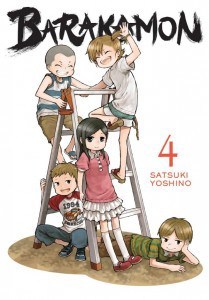S.Q. Eries's Blog, page 44
September 29, 2015
Manga Review: Kiss of the Rose Princess Vol. 4
 Magical girls and reverse harems are standard fare in shoujo manga, and you can find both in Aya Shouoto’s Kiss of the Rose Princess. Read on for Volume 4 of the series! (For my review of previous volumes, click here.)
Magical girls and reverse harems are standard fare in shoujo manga, and you can find both in Aya Shouoto’s Kiss of the Rose Princess. Read on for Volume 4 of the series! (For my review of previous volumes, click here.)
The Review
The events of Volume 3 finally give the Rose Knights something to do that falls into the fate-of-the-world-depends-on-it category. However, their first step to sealing the Demon Lord seems more of an excuse to show off the Rose Knights’ good looks and make Anise cross-dress. Their flippant attitudes toward the idol contest despite its supposedly vital prize makes it difficult to take any of it seriously.
When Rhodecia pop onto the stage and reveal themselves as Roses Lime and Orange, the story looks like it might rev up into battle mode, but the fight devolves into more bishounen strutting and posing. Not surprisingly, big bad daddy Schwartz, who’s strangely absent despite his new school position, is behind the idol pair, and their target is Anise. And like the Yellow Rose, Lime and Orange’s first head on confrontation with the Rose Knights appears to be their last.
Supposedly, Anise has twenty-two more Arcana cards to retrieve, and considering adversaries Lime, Orange, and Yellow have been such a short-lived challenges, I anticipated the process of collecting the remaining cards to be encounters with a rainbow spectrum of bishounen roses. As such, I was surprised to discover their next enemy is female. Although the amusement park setting for their showdown is almost as cheesy as the idol contest, Mikage Hiragi exudes a much more sinister aura than Rhodecia. That plus the Black Rose’s reawakening memories give this arc a much darker tone than the idol contest airhead silliness. Still, Shouoto-sensei has a way to go in balancing the comic and dramatic elements of this series.
Extras include the opening splash illustration and table of contents printed in color; character profiles and story thus far; a mini-manga about the mangaka and her editor; and bonus illustrations.
In Summary
The fate of the world depends on… an idol contest? Anise and company have to keep evil from overtaking the world, but you can’t really tell from their attitudes or the opponents they face. Most scenes don’t seem to have much point other than showing off how hot the guys around Anise are. Meanwhile, it remains unclear why Dad/Schwartz is playing the part of Anise’s nemesis in all of this. If all you want are illustrations of a variety of 2-D bishounen, Kiss of the Rose Princess delivers. However, if you want an understandable plot, look elsewhere.
First published at The Fandom Post.


September 22, 2015
Manga Review: Are You Alice? Vol. 8
 Lewis Carroll’s Alice in Wonderland has inspired all sorts of spinoff works, from visual art to movies to manga. However, Ai Ninomiya may have conjured up the most unusual Alice yet. Are You Alice?, which originally began as a CD series, features a gun-toting male as its Alice! Yen Press has recently released the eighth volume, and you can read on for the review. (If you’re interested in my reviews for previous volumes, click here.)
Lewis Carroll’s Alice in Wonderland has inspired all sorts of spinoff works, from visual art to movies to manga. However, Ai Ninomiya may have conjured up the most unusual Alice yet. Are You Alice?, which originally began as a CD series, features a gun-toting male as its Alice! Yen Press has recently released the eighth volume, and you can read on for the review. (If you’re interested in my reviews for previous volumes, click here.)
Back Cover Blurb
After the Alice Fixed Holiday, Alice is ready to return to the task at hand: killing the White Rabbit. But Hatter, determined to break his fealty to the Queen of Hearts and get his time moving again, has other ideas. He leaves Alice in the hands of a courtly armed stranger with a horse-drawn carriage ready to take Alice to the Land Through the Looking-Glass… as its queen?! When Alice and Hatter meet again through the looking-glass not long after, will bodyguard and ward still be on the same page?
The Review
The Alice Fixed Holiday ends, and an intriguing arc begins. With it, we get three new characters and a change of setting. The Land Through the Looking Glass is Alice’s new locale, and the one who guides him there is a handsome gentleman, who is as attentive as the Hatter is indifferent. He doesn’t give his name, but the 88th Alice makes mention of a “White Knight” so perhaps that’s his name? At any rate, the guy wants to make Alice his queen, and it’s fun watching Alice weep from the royal treatment.
As for our other newcomers, they are Tweedle Dee and Tweedle Dum, and they are nothing like the dumpy Disney version. The Tweedles are a pair of bishounen twins, and in this Wonderland story, they are the “Regrets Reissuer” and “New Name Issuer.”
There’s a lot of situational comedy in these chapters as Alice does everything from mangling the Tweedles’ names to freaking out at the Nameless Forest to getting lost in the Land Through the Looking Glass palace. The funny bits are entertaining, but what really makes this arc engaging are the numerous flashbacks to the real Alice and the origins of the White Knight, the Tweedles, and most interestingly, the Cheshire Cat.
On the surface, The Land through the Looking Glass looks like a big detour from the Game to Kill the White Rabbit. However, between the glimpses of the past and revelations from the Tweedles, the story cleverly winds back to the rabbit, and on the way, delivers a stronger sense of the White Rabbit’s intentions and how he’s controlled the Game. While we get more pieces to the puzzle that is the 89th Alice and his “sister,” the truth remains a mystery. The only thing that’s clear is that Wonderland is caught in an endless loop, and it will take something drastic to break the cycle.
Manga extras include closing remarks from the creator and the title page and table of contents printed in color.
In Summary
New characters, new setting, and, best of all, new insights. Through a mix of flashbacks and confessions, we get a glimpse of the myriad motives at play in the Game to Kill the White Rabbit as well a better look into the world of the real Alice. Between these tantalizing revelations and a series of comic interactions, Volume 8 makes a fun and thrilling read.
First published at the Fandom Post.


September 15, 2015
Manga Review: My Love Story!! Vol. 3
 Takeo Goda, the male lead for Viz Media’s My Love Story!! is quite unusual. Bishonen tend to dominate the cast of shojo manga, but Takeo’s looks are about as far from a stereotypical pretty boy as you can get. Still, he possesses tremendous appeal in this hilarious romantic comedy. I had the opportunity to take a look at Volume 3 of the series, and you can read on for the review.
Takeo Goda, the male lead for Viz Media’s My Love Story!! is quite unusual. Bishonen tend to dominate the cast of shojo manga, but Takeo’s looks are about as far from a stereotypical pretty boy as you can get. Still, he possesses tremendous appeal in this hilarious romantic comedy. I had the opportunity to take a look at Volume 3 of the series, and you can read on for the review.
Back cover blurb
Takeo Goda is a giant guy with a giant heart. Too bad the girls don’t want him! (They want his good-looking best friend, Sunakawa.) Used to being on the sidelines, Takeo simply stands tall and accepts his fate. But one day when he saves a girl named Yamato from a harasser on the train, his (love!) life suddenly takes an incredible turn!
The Review
Takeo’s got to be one of the purest manga characters I’ve come across. He’s obviously head over heels for Yamato, but as the first two chapters of Volume 3 demonstrate, he’s a gentleman no matter what the circumstance. In Chapter 8, a romantic picnic turns into an unexpected overnight adventure when he and Yamato tumble off a cliff. (In any other series, this would be ridiculous, but given their history of falling beams and burning buildings, it’s par for the course.) As usual, Takeo doesn’t pick up on the real cause of Yamato’s nervousness as they wander alone, but he’s sweet and funny as he takes down everything from mosquitoes to wild boars for her sake.
In Chapter 9, Yamato ups her game by proposing a group trip to the beach. The beach means swimsuits, and Yamato’s friends go all out to help her find the right swimsuit to knock Takeo for a loop. At the same time, Takeo’s chewing his friends out for even thinking about ogling at girls so it’s pretty funny when they get to the beach and both get overwhelmed by the physicality of the other.
One nice thing about this volume is that Takeo gets a chance to be popular. While people often perceive him as the scary guy, he’s capable of drawing a crowd (in a positive way) and does so in Chapters 9 and 11. (The drawings showing his prowess on the beach, skating rink, and soccer field are pretty funny, too). Given that Yamato is the “cute” one in the relationship, it came as a surprise to see her concerned about other girls stealing Takeo (I’d just written off big sis Ai as a fluke). Having that element of jealousy play out in their growing relationship is interesting, but what’s really gratifying is watching a girl who dissed Takeo in middle school realize that he’s actually kind of cool.
Extras include story thus far, notes from the creators, and a three-page bonus mini-manga.
In Summary
Volume 3 consists of four standalone chapters. Although the story arcs are brief, their entertainment value remains high. They follow the same basic premise of Takeo’s devotion to Yamato and her gushing admiration for him, but there’s enough variation in the details (such as Takeo’s parents taking interest in Yamato) that keeps the story fresh and funny. Plus, it’s hard not to laugh at Aruko-sensei’s hilarious visuals.
First published at The Fandom Post.


Manga Review: My Love Story Vol. 3
 Takeo Goda, the male lead for Viz Media’s My Love Story!! is quite unusual. Bishonen tend to dominate the cast of shojo manga, but Takeo’s looks are about as far from a stereotypical pretty boy as you can get. Still, he possesses tremendous appeal in this hilarious romantic comedy. I had the opportunity to take a look at Volume 3 of the series, and you can read on for the review.
Takeo Goda, the male lead for Viz Media’s My Love Story!! is quite unusual. Bishonen tend to dominate the cast of shojo manga, but Takeo’s looks are about as far from a stereotypical pretty boy as you can get. Still, he possesses tremendous appeal in this hilarious romantic comedy. I had the opportunity to take a look at Volume 3 of the series, and you can read on for the review.
Back cover blurb
Takeo Goda is a giant guy with a giant heart. Too bad the girls don’t want him! (They want his good-looking best friend, Sunakawa.) Used to being on the sidelines, Takeo simply stands tall and accepts his fate. But one day when he saves a girl named Yamato from a harasser on the train, his (love!) life suddenly takes an incredible turn!
The Review
Takeo’s got to be one of the purest manga characters I’ve come across. He’s obviously head over heels for Yamato, but as the first two chapters of Volume 3 demonstrate, he’s a gentleman no matter what the circumstance. In Chapter 8, a romantic picnic turns into an unexpected overnight adventure when he and Yamato tumble off a cliff. (In any other series, this would be ridiculous, but given their history of falling beams and burning buildings, it’s par for the course.) As usual, Takeo doesn’t pick up on the real cause of Yamato’s nervousness as they wander alone, but he’s sweet and funny as he takes down everything from mosquitoes to wild boars for her sake.
In Chapter 9, Yamato ups her game by proposing a group trip to the beach. The beach means swimsuits, and Yamato’s friends go all out to help her find the right swimsuit to knock Takeo for a loop. At the same time, Takeo’s chewing his friends out for even thinking about ogling at girls so it’s pretty funny when they get to the beach and both get overwhelmed by the physicality of the other.
One nice thing about this volume is that Takeo gets a chance to be popular. While people often perceive him as the scary guy, he’s capable of drawing a crowd (in a positive way) and does so in Chapters 9 and 11. (The drawings showing his prowess on the beach, skating rink, and soccer field are pretty funny, too). Given that Yamato is the “cute” one in the relationship, it came as a surprise to see her concerned about other girls stealing Takeo (I’d just written off big sis Ai as a fluke). Having that element of jealousy play out in their growing relationship is interesting, but what’s really gratifying is watching a girl who dissed Takeo in middle school realize that he’s actually kind of cool.
Extras include story thus far, notes from the creators, and a three-page bonus mini-manga.
In Summary
Volume 3 consists of four standalone chapters. Although the story arcs are brief, their entertainment value remains high. They follow the same basic premise of Takeo’s devotion to Yamato and her gushing admiration for him, but there’s enough variation in the details (such as Takeo’s parents taking interest in Yamato) that keeps the story fresh and funny. Plus, it’s hard not to laugh at Aruko-sensei’s hilarious visuals.
First published at The Fandom Post.


September 8, 2015
Manhwa Review: Goong Vol. #18
 What if modern Korea was a constitutional monarchy similar to England’s? That’s the backdrop for Goong: the Palace, a manhwa that got turned into a wildly popular drama and musical.
What if modern Korea was a constitutional monarchy similar to England’s? That’s the backdrop for Goong: the Palace, a manhwa that got turned into a wildly popular drama and musical.
Set in an alternate world where the Korean monarchy still exists, the story follows Chae-Kyung Shin, a strong-willed commoner who attends the same high school as Shin Lee, the crown prince. After accidentally witnessing Shin proposing to his girlfriend Hyo-rin and being rejected, Chae-Kyung unexpectedly learns that she will marry Shin and become crown princess due to a promise between the former king and her grandfather.
Yen Press has released the final volume, and you can read on for the review. (For my review of previous volumes go here.)
Back Cover Blurb
During the royal family’s first public interview with Prince Sun, the nation is shocked when the youngest prince accidentally reveals Shin’s intention to get married and leave the palace! Recognizing Sun’s voice from her mysterious phone call a few nights before, Chae-Kyung drags her new boyfriend to the royal family’s parade. Shin spots her from the car, and Chae-Kyung follows him to the palace, where they are reunited…
The Review
The tale of the commoner girl in the Korean palace finally comes to a close. With the series wrapping up, Creator Park needs to tie up loose ends, and there are a lot to be addressed. The first three chapters bring resolution to the Hyo-Rin/Chae-Jun, Eunuch Kong/Lady Han, and King/Queen pairings. Even Yul’s mother gets a kind of resolution although it makes the fuss over her medicine to the king look like the molehill that got turned into a mountain.
Having addressed the secondary characters, the focus turns to Shin and Chae-Kyung. The previous volume made it look like Chae-Kyung’s new boyfriend really had a shot at capturing her heart. At the very least, he seemed genuinely attracted to her, but then we learn they haven’t even kissed. In addition, he so understanding when Chae-Kyung starts obsessing over Shin again, he’s more like a super supportive guy friend than a serious contender for her heart. Meanwhile, Shin hasn’t picked up anyone new despite the Eagles’ attempts to get him with another girl so the last hurdle in the relationship is simply Shin’s position as Crown Prince. That doesn’t quite create the same drama as torn heartstrings or diabolical plots. As such, it’s a bit anti-climactic when they reunite, especially when the solution to their problem has been in the background the entire time. Even so, our lead couple has been through so much it is satisfying to see them finally achieve a happy ending.
Yen Press’s Volume 18 consists of Volumes 27 and 28 of the Korean release. The main story concludes in the Korean Volume 27, and Volume 28 is comprised entirely of side stories. These include “A Concubine’s Confession,” a time travel tale; “A Crown Princess’s Secret Diary,” in which Chae-Kyung pokes fun at her stuffy husband; “Debating with the Enemy,” a Yul-centric piece that goes off the deep end; “The Story of Spending a Night Together,” an extended account of the royal adults’ failed attempt to get Chae-Kyung and Shin to sleep with each other; and a couple of mini-manhwa about Park’s various experiences. Except for “A Concubine’s Confession,” these extras are heavy on Park’s particular brand of raunchy comedy, and if that’s been your favorite aspect of Goong, it’s not a bad way to close out the volume.
In Summary
The long-running palace dramedy comes to an end. There are more happy endings than not, and of course, our main couple finds a way to be together, although their reunion is less dramatic than I expected for a series finale. The Goong characters did a great job of keeping the audience hooked, but it does feel like it’s time for them to retire. For those who aren’t quite ready to let them go, Goong’s conclusion is followed by a number of short stories, which revisit the past and provide a possible (?) glimpse of the characters’ future.
First published at the Fandom Post.


September 1, 2015
Manga Review: Sword Art Online: Progressive Vol. 002
 Sword Art Online was undoubtedly one of the most popular anime of 2012. Based upon a series of light novels by Reki Kawahara, SAO’s near-future characters, gorgeous fantasy setting, and life-or-death stakes drew an enthusiastic fan following. Yen Press has recently released Volume 2 of the Sword Art Online: Progressive manga adaption, and you can read on for the review. (For my review of other Sword Art Online manga, click here.)
Sword Art Online was undoubtedly one of the most popular anime of 2012. Based upon a series of light novels by Reki Kawahara, SAO’s near-future characters, gorgeous fantasy setting, and life-or-death stakes drew an enthusiastic fan following. Yen Press has recently released Volume 2 of the Sword Art Online: Progressive manga adaption, and you can read on for the review. (For my review of other Sword Art Online manga, click here.)
Back Cover Blurb
The party is shaken when their leader, Diavel, is struck down by the boss of the very first floor. Asuna and her teammates are confronted for the first time with the cruel reality of their situation: Sword Art Online is no mere game–death here is final. Their commander lost, the remaining fighters begin to lose heart and plan their retreat. But the fight must go on if they are to escape this game world, and in his dying moments, Diavel managed to convey his appointment for the next commander–Kirito!
The Review
As in the anime, the battle with the first floor boss ends with Diavel dead and Kirito dubbed a beater. However, Progressive puts its own spin on the fight. For one, Asuna takes more of a commanding role, showing hints of the guild leader she’s going to become. For another, the emotional aftermath is more complicated. Interestingly, sourpuss Kibaou, who started the beta/cheater/beater uproar against Kirito in the anime, winds up sympathizing with him in this scene. Kirito and Asuna still have a private conversation before Kirito goes off on his own, but Progressive’s version is more prolonged and has a distinct romantic tension to it.
Going into Chapter 008, it’s all completely new material. Both the Aincrad manga and the anime gloss over Floor 2, but we get to watch events progress gradually even as Asuna gradually improves. She’s not the only one having to sort herself out in the early days of SAO, though. Chapter 009 provides a glimpse of the beginnings of the guilds, and at this point, they’re a lot of fancy names and swagger and not much else.
Overall, the tone on Floor 2 is much lighter than I anticipated. Perhaps that’s because the only fight thus far is against a field boss that looks like a big bull. When the players take it on, they seem more concerned with who gets the glory of being on the front rather than the risk of a fatal hit. As such, it really does feel more like a “game” rather than the constant life/death struggle of Aincrad, especially when Asuna and Kirito compete to see who can take out the most windwasps for shortcake.
Asuna’s continued interactions with Kirito are also a surprise. The anime and Aincrad made it seem like the two didn’t cross paths again until Asuna had joined the Knights of the Blood, but in Progressive, they meet again days after clearing Level I. The two have a great rapport, and while Asuna is intrigued by Kirito, he’s obviously besotted by her. For those who were not so thrilled with the harem aspect of the SAO anime, this version of Asuna and Kirito’s early relationship might prove an enjoyable alternative.
Extras include the title page and table of contents in color, bonus illustration from artist Tomoya Haruno, and closing remarks from the creators.
In Summary
Progressive continues to deliver a strong storyline with artwork to match. In addition to showing Asuna’s development as a fighter, we also see players organizing the beginnings of the guilds as they proceed through Aincrad’s Floor 2. Interestingly, the plot includes more early interaction between Asuna and Kirito. Although that deviates somewhat from the beater/solo fighter persona Kirito had in the anime, Asuna/Kirito fans will probably enjoy seeing Kirito’s early attraction to Asuna.
First published at the Fandom Post.


August 25, 2015
Manga Review: Barakamon Vol. 4
 The contrast between city and rural life has been a source of entertainment since the time of Aesop’s fables. It remains a popular subject in manga and anime today, and joining the ranks of Silver Nina, Non Non Biyori, and Silver Spoon is Yen Press’ series Barakamon. Read on for my review of Volume 4! (For my reviews of previous volumes, click here.)
The contrast between city and rural life has been a source of entertainment since the time of Aesop’s fables. It remains a popular subject in manga and anime today, and joining the ranks of Silver Nina, Non Non Biyori, and Silver Spoon is Yen Press’ series Barakamon. Read on for my review of Volume 4! (For my reviews of previous volumes, click here.)
Back cover blurb
Aiming for an autumn calligraphy exhibition, handsome young calligrapher Seishuu Handa sets out to get in touch with his creative side. Meanwhile, a man whose appearance screams “yakuza,” landing him well out of place on the peaceful island, puts in a “request” to have Handa write the name on his boat…?! Kick back like a local and enjoy the fourth volume of this heartwarming island comedy!
The Review
Volume 3 left Handa with no means of communication following a powerful typhoon. I thought it would be a lead-in for another extended arc like the Tokyo visitors one, but it merely flows into a single chapter about Handa’s laughable attempts to use a rotary phone before switching back to Barakamon’s usual pattern of standalone chapters. The content is pretty entertaining though as Yoshino-sensei expands beyond the kids-getting-in-Handa’s-way storylines and into territory where Handa and Naru are collaborating on something. I found the fish preparation chapter especially funny, having dealt with overly lively fish myself.
However, Volume 4 does have a new feature: chapters rendered in four-panel style. Chapter 29, in which Handa and Naru catch dragonflies, and Chapter 32, which features a calligraphy tutoring session with the local kids, use this format along with a simplified character design. Because of this style, these pages have more of a gag manga feel. The humor in Chapter 29 is mostly visual so it translates pretty well, but the kanji-based jokes in Chapter 32 may require a visit to the cultural notes. In general, though, they’re pretty amusing, and except for some yaoi allusions, everything stays in “All Ages” territory.
The volume closes with a chapter on the Obon Festival. In addition to showing Gotou’s particular take on the Japanese holiday, it also touches on a subject I’ve wondered about, namely Naru’s parents. We’ve seen plenty of her grandpa, but her parents have yet to make an appearance. For a community that’s so unnecessarily well-informed about their neighbors, it’s a little strange Handa’s yet to learn anything about them, and I’m guessing that will provide fodder for future chapters.
Extras include a bonus three-page manga, translation notes, and information about the story’s island setting.
In Summary
After the extended arc in Volume 3, Barakamon returns to its pattern of standalone chapters. Themes range from Handa painting the name onto a local’s boat to managing the food gifts lavished by his rustic neighbors. The volume ends by touching on Naru’s family situation. Until now she’s been a pretty simple character, but the story hints that the boisterous, free-spirited kid might turn into something more complicated for Handa.
First published at The Fandom Post.


August 18, 2015
Manga Review: Manga Dogs Vol. 3
 From Bakuman to School Rumble, the manga/anime industry has been a popular subject of manga and anime in recent years. Now joining their ranks is Kodansha’s manga series Manga Dogs, and you can read on for my review of Volume 3. (For my review of earlier volumes, click here.)
From Bakuman to School Rumble, the manga/anime industry has been a popular subject of manga and anime in recent years. Now joining their ranks is Kodansha’s manga series Manga Dogs, and you can read on for my review of Volume 3. (For my review of earlier volumes, click here.)
Back cover blurb
Teenage manga artist Kanna Tezuka’s series about a high school for Buddhist statues is facing cancelation! Meanwhile, the manga course that’s given her so much free time to draw at school is under threat from a principal taken with the next big thing: light novels! Their teacher’s solution to this existential crisis is an inspiring field trip, but will it be enough to get these dogs to start drawing at last?!
The Review
The appearance of the new editor-in-chief at the end of Volume 2 made it seem like the story was heading in a new, strong direction. Sadly, it winds up much like the kidnapping arc. The threats breathed by the editor turn out to be nothing at all, and the arc wraps up within the first chapter of Volume 3 without any real consequences for Kanna.
The manga then returns to its usual course of standalone chapters with Kanna’s three dogs blowing all sorts of hot air while avoiding anything remotely connected to drawing. Chapter 30 is unusual in that we see a happy, dressed up Kanna, but for the most part, she’s the same snark and sarcasm she’s always been. As in Volume 2, she doesn’t seem to enjoy being a mangaka, and even turns an invitation to a magazine publisher’s party into something to be depressed about. Toyama-sensei tries to liven things up by making Shota’s sister, Kanna’s editor, and the school principal wackier, but for the most part, it’s the same tired themes we’ve seen over and over.
The final arc feels a bit random. It begins with a kind of manga history lesson and ends with Kanna’s class actually creating manga together. While a Japanese audience might appreciate reading about past mangaka, most references will probably go over the heads of Western readers. The story then awkwardly segues to the impending cancellation of the manga class and the students’ last-ditch effort to prove themselves. Kanna’s heroic leadership over their joint collaboration seems really forced considering the boys are shiftless as they ever were. Perhaps it’s meant to be inspiring, but when the boys start doing their usual whining about work, I’m ready to pull the plug on the class.
Extras include the opening illustration and table of contents printed in color; translation notes; short bonus manga; and author afterword.
In Summary
Manga Dogs reaches its final volume, and to be honest, it’s a relief. Its characters weren’t likable, and the humor never was that clever. I’m actually surprised it lasted three volumes. Considering how pointless the storylines were, Manga Dogs really had to be put out of its misery.
First published at The Fandom Post.


August 11, 2015
Manga Review: Barakamon Vol. 3
 The contrast between city and rural life has been a source of entertainment since the time of Aesop’s fables. It remains a popular subject in manga and anime today, and joining the ranks of Silver Nina, Non Non Biyori, and Silver Spoon is Yen Press’ series Barakamon. Read on for my review of Volume 3! (For my reviews of previous volumes, click here.)
The contrast between city and rural life has been a source of entertainment since the time of Aesop’s fables. It remains a popular subject in manga and anime today, and joining the ranks of Silver Nina, Non Non Biyori, and Silver Spoon is Yen Press’ series Barakamon. Read on for my review of Volume 3! (For my reviews of previous volumes, click here.)
Back cover blurb
Kawafuji, the only friend of handsome young calligrapher Seishuu Handa, has come to visit the island…!! However, the lack of cell phone signal and any useful landmarks is preventing the two of them from meeting up!! And who is this Kyousuke Kamisaki who’s come along for the ride…? There’s a storm brewing in the third volume of this sophisticated (?), heartwarming island comedy!!
The Review
The “Handa’s visitors from the city” arc is the best this series has delivered so far. Two Tokyoites come to the island to find Handa, and all sorts of misunderstanding and mayhem erupt. Part of the reason these chapters are so fun is because Handa’s not the sole butt of the ignorant-city-slicker type jokes. Also, the kids, who usually are the ones doing the mocking, wind up looking pretty foolish for Handa’s sake.
The other reason these chapters are so entertaining is because Handa’s visitors are unlike anything I expected. I assumed they had to be good friends given the three hour trip to Gotou, but eighteen-year-old Kousuke Kanzaki is anything but. He’s a rival and an obsessed one. Despite never having met Handa before, Kousuke comes to Gotou to embarrass, provoke, and belittle Handa. On the other hand, visitor Kawafuji actually is a good friend of Handa’s. He spends most of the arc drunk/hung over, but when he does sober up, he provides insight into the type of person Handa was and how he’s changed since his move.
Handa’s two visitors cause him to reflect on these changes himself. However, it’s not until Naru gets her hands on Kousuke’s calligraphy magazines that readers realize how badly Handa wants to transform himself. For once, Naru’s actually spreading factual information on the island gossip network, and though I don’t quite understand Handa’s embarrassment, it’s still pretty funny watching the locals ask him for autographs.
Then Kousuke and Kawafuji leave, and it’s back to Handa being the sole stupid city boy in time for a typhoon to hit the island. While his ignorance is an element of the story, the island’s strong neighborly culture and spooky stories (like the type kids tell at camp) factors in as well. It’s an odd combination but works in getting laughs and setting Handa up with his next dilemma: destroyed home electronics.
Extras include a character lineup, bonus five-page manga, translation notes, and information about the story’s island setting.
In Summary
Lively comedy abounds when Handa gets guests from Tokyo. Not only do they provide two more variations on the city-boy-in-the-country theme, but the local kids revert to some crazy distraction tactics when they realize one of the visitors is Handa’s rival. In the midst of bug attacks and severe hangovers, we get a clearer picture of pre-Gotou Handa, which Yoshida-sensei manages to turn into a new flavor of embarrassment for our resident calligrapher. All in all, Volume 3 is a fun read with a nice mix of humor.
First published at The Fandom Post.


August 4, 2015
Manga Review: Yukarism Vol. 2
 Geishas are an icon of Japanese culture that, although their heyday is long post, continues to fascinate Westerners to this day. If you’ve wondered about the lives of these flowers of Japan’s bygone pleasure districts, you may want to consider Chika Shiomi’s historical/time slip manga, Yukarism. Read on for my review of Volume 2. (For my review of Volume 1, click here.)
Geishas are an icon of Japanese culture that, although their heyday is long post, continues to fascinate Westerners to this day. If you’ve wondered about the lives of these flowers of Japan’s bygone pleasure districts, you may want to consider Chika Shiomi’s historical/time slip manga, Yukarism. Read on for my review of Volume 2. (For my review of Volume 1, click here.)
The Review
Things get more interesting for Yukari with the arrival of his temporary housekeeper Katsuhiko Satomi, but they get really interesting for Satomi and Mahoro. Before, Yukari merely saw hints of previous lives manifesting in their reincarnated souls. Now, old grudges actually impact the present when Satomi and Mahoro meet.
Possessed is probably the most accurate way to describe what happens to the two. Not only does their old hatred consume them, the skills of their previous lives manifest despite neither having trained in swordsmanship or magic. However, Mahoro and Satomi are only vaguely aware of what’s happening. One moment they’re literally trying to kill one another, and the next they snap back to their senses, embarrassed and apologizing profusely. These moments of possession occasionally have a comic effect, but for the most part, it’s creepy, especially with Shiomi-sensei’s illustrations of black magic in the background.
Yukari’s forays to the past also take on a different tone. Before, his episodes in Yumurasaki’s body were merely amusing, but that changes when he returns to the Edo period and finds himself in bed with witch doctor Takamura. (Ummm… yeah. Yumurasaki’s a courtesan, and even though all the vital parts are covered, it’s pretty obvious what Takamura’s trying to do in that scene). Yukari confesses to Takamura that he is Yumurasaki’s reincarnated soul, and being a magician, Takamura understands that it’s true. The interaction that follows not only causes Yukari to question his original preconceptions about Takamura, it helps him understand himself better as a reincarnated being.
Another character whose image gets shattered in this volume is Mahoro. The narrative reveals chilling details about her background. She’s definitely not the person Volume 1 led readers to believe she was. Yukari remains ignorant of what Mahoro’s truly capable of but given the irrepressible hate between her and Satomi, I doubt that will remain the case for long.
Extras include a bonus one-page manga, translation notes, and author bio.
In Summary
For Yukari to investigate Yumurasaki’s death isn’t particularly gripping when s/he’s already been reincarnated, but when the hostilities of the past invade Yukari’s present life, the story gets a lot more compelling. In addition, Shiomi-sensei throws readers for a loop by blowing apart some of the assumptions of Volume 1. The story occasionally takes on the flavor of a horror flick when the Kazuma/Takamura feud reasserts itself in the present, but Yukari’s interactions with the past now actually take on meaning and purpose.
First published at The Fandom Post.





